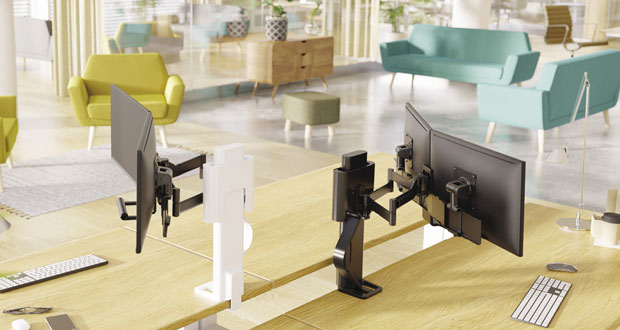 With a recent survey revealing that workplace wellbeing is a priority for staff, it’s time to invest in workspace technology to support the health, safety and wellbeing of workers, says Paul Zuidema, Managing Director EMEA, Ergotron
With a recent survey revealing that workplace wellbeing is a priority for staff, it’s time to invest in workspace technology to support the health, safety and wellbeing of workers, says Paul Zuidema, Managing Director EMEA, Ergotron
Over the last 18 months, the world of work has changed, most likely forever – from fixed corporate office workstations to a more flexible blend of remote, office, and home-based workspaces. As the new generation of tech-native and influential Gen-Z workers assume their places to drive our economic future, the balance of power has tipped in favour of employees in making decisions over how and where they work. These changes mean that technology and equipment that supports comfort and productivity can no longer be limited to the office. This begs the question, are employers ready for this change?
According to a recent survey by Ergotron , nearly three quarters of UK workers (73 per cent) would choose their next employer based on the provision of flexible technology and wellbeing support. If this isn’t enough of a wake-up call, it may not be long before there is UK Government legislation to support the needs of remote and home-based workers. There is a growing need for employers to prioritise the development of a clear flexible working strategy which promotes the health and wellbeing of their employees. As they reduce their corporate building footprint, employers now need to be ready to scale up provision for their workers to communicate, connect, and create – wherever they may be located.
THE IMPORTANCE OF OFFICE DESIGN
As a result of the pandemic normalising remote work, workers are unsurprisingly choosing not to return to the office full time. Software comparison company Capterra surveyed an international group of 4,600 employees to find the extent they would like to work full time in the office after the pandemic, and found that one third of home workers do not want to return to working solely in the office.
At the same time, many large organisations are already revising their return-to-work strategies and reviewing their corporate office space. A Fortune/Deloitte survey found that up to 76 per cent of CEOs think they will need less office space in the future. Since then, Deloitte made the controversial announcement to do away with its global offices, while retailer Ralph Lauren announced it was cutting corporate office space by 30 per cent, making it one of many companies to downsize their physical space over the past two years.
There are now critical factors for employers to consider when revising their return-to-work strategies to accommodate the now-normal hybrid embodiment of work environments. This includes the need to embrace flexible technology which best facilitates collaboration between teams. It is a priority that they address the design of working spaces, by creating workspaces that reduce stress and facilitate collaboration, for an improved employee working ‘experience’.
The findings of the Ergotron survey (conducted by independent research agency, Research Matters, of employees who work entirely or partly from home since the pandemic) reveals employees’ needs and preferences around work styles and conditions. Factors such as the option to stand or sit while working, noise, room lighting, and temperature may all have an impact on productivity. Employers need to listen to how their workers want to work and be aware of what constitutes ergonomic furniture and flexible technology for employees.
With open plan offices linked to more stress, lower morale and productivity, new concepts for office layouts are required, along with provision of in-office and at-home equipment, to promote productivity and give employees choice.
THE NEED TO OPTIMISE OFFICE EQUIPMENT
Just as it’s crucial for employees to be provided with the right applications and technology solutions to do their jobs, it is vital to provide suitable equipment for them to carry out their roles. The Ergotron survey reveals that often furniture, tools or technology employers think is important differs from the view of the employee. The survey found that 84 per cent of UK employees consider an ergonomic chair highly important for their roles, yet only 22 per cent of the employees polled have been provided with such a chair.
Personalised technology and easy customisation are vital for flexible working. In desk-based roles, this needs to factor in positioning chairs and desks at the optimum height for each employee. Customisable equipment which moves easily is a key consideration; for instance ergonomic seating, large screens, flexible monitor arms, adaptable workstations, and mobile desks.
Workspace tools should benefit productivity, while also supporting employee comfort and health. Health problems that arise because of poorly appointed equipment, such as back problems, should be the responsibility of the employer. Sitting for long stretches may cause healthcare problems and the UK’s next generation of workers have strong views on moving while at work. In fact, 71 per cent of workers surveyed aged 18-24 consider it important to be able to switch between sitting and standing while working.
The answer to successful flexible working lies in personalised technology, which should be easy to move and customise. A height-adjustable work surface lets employees vary their working posture throughout the day and discourages sitting continuously for eight hours. Ergotron’s research shows that 64 per cent of employees consider a height-adjustable work surface to be hugely important. This includes ensuring every station has an easy-to-adjust display; shared workspaces should have a monitor arm that’s easy to adjust and position by hand.
It is an additional advantage if the monitor arm can support multiple screens. The research showed that employees across all the age ranges favoured this, with 62 per cent of those surveyed aged 25-34 and 73 per cent of over 55s considering it important to work with two monitors. A dual monitor also allows employees to quickly transform their desks into collaboration stations, so they can share screens with colleagues for integrated work.
Shared workspaces require additional considerations. Most employees (84 per cent) find it very important to be able to hold meetings when part of the team is in the office and the rest are working remotely. Work tools must be easy to unplug and move, so employees can find a suitable space for each activity or need throughout the day. The survey also shows that 75 per cent of employees find it important to be able to easily switch between workspaces, which means that portable devices are vital.






